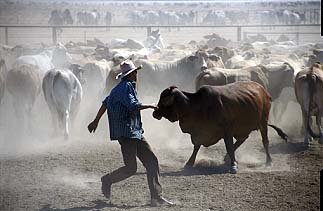Fertility is one of the most important aspects of a beef breeding business. Fertility tends to be an overarching term applied to the number of calves that are born each year. Maximising the number of calves born and weaned annually requires attention on several areas in the herd.
While bull fertility is a significant contributor, there is also the aspects of female fertility. Female fertility is impacted directly by daily energy intake. This influences her condition score, and her ability to produce the hormones required to trigger ovulation and place the female in cycle for conception when exposed to a bull.
One area that I have often wanted my clients to focus on is the time between calving and re-joining. This period is a critical window for producers, as it determines if you will achieve a calf born every 12 months. A 12-month calving is the key benchmark for many herds striving to maintain or improve fertility and ultimately herd productivity.
“A 12-month calving is the key benchmark for many herds striving to maintain or improve fertility and ultimately herd productivity.”
This window is set by several boundaries. The first is the actual period taken by gestation. In cattle, gestation length is an average of 282 days. As an average, this means there will be some animals that calve earlier, and some a bit later. The other time component is the length of time that females require to recovery from calving ahead of a return to oestrus.
This period can be influenced by the nutritional levels of feed on offer. It is also impacted by the age of the female as well as a sight genetic influence.
There are some significant advantages in having females which can join earlier. An early joining which in turn results in an earlier calving buys the female some time ahead of the next calving season. For instance, joining over a 6 – 9-week period would see those early calving females have several additional weeks to recover and return to oestrus for the next joining.
As well as this advantage, naturally enough, those females who calve earlier will have several weeks advantage for their calves who can express additional growth compared to those born in the middle and end of the joining period. This adds significantly to weaning weight and offers a chance to select replacements from animals that are slightly older and heavier from the new generation.
A shorter calving interval offers significant financial benefits as well. Research shows significant differences between herds that calve over 2 months and those with a longer (5 month) calving period. The average difference in calf weaning weight is around 28kgs, which on the current EYCI values is $9.96 / kg translates to $278.88 / head
A calf every 12 months should be the major target for breeding herds
Shortening calving is therefore a financially rewarding ambition for beef herds. There are several ways to approach this ambition.
Management Targets
Ideally females should be calved in a Fat Score of 2.5 – 3.5. This means carefully managing pre calving nutrition. It also means that heifers or cows that are lighter in condition will take longer to recover before returning to oestrus.
For producers with lighter females, this could be addressed by increasing energy in the daily ration for lactating cows. It’s important to remember that once calving occurs, females’ energy intake doubles. This extra energy is often provided by metabolising fatness. So, producers with light cows should supplement to make the ration meet the increased demands for the females.
Selection Targets
While fertility is strongly influenced by environmental impacts – particularly nutrition, it is possible to select for those animals which are genetically suited to be more fertile and likely to conceive earlier.
This can be done through using selection tools such as the Days to Calving EBV and the Gestation Length EBV.
The Days to Calving EBVs are estimates of genetic differences between animals in the time from the start of the joining period (i.e., when the female is introduced to a bull) until subsequent calving. Lower, or more negative, Days to Calving EBVs are generally more favourable.
Gestation Length EBVs address the time between the bull entering the herd and conception.
Gestation length can be defined as the period from the date of conception (i.e., when the female gets in calf) to when the subsequent calf is born. Shorter gestation length is generally associated with lighter birth weight, improved calving ease and improved re-breeding performance among dams. In addition, calves born with a shorter gestation length may be heavier at weaning due to more days of growth post-birth. Lower or more negative Gestation Length EBVs are more favourable.
Improving fertility requires addressing long and short term goals in the herd
Combining long term selection with strategic management is the most effective way to move fertility levels towards more productive and financially rewarding levels. The process should be seen as a combination of short- and long-term goals.


















